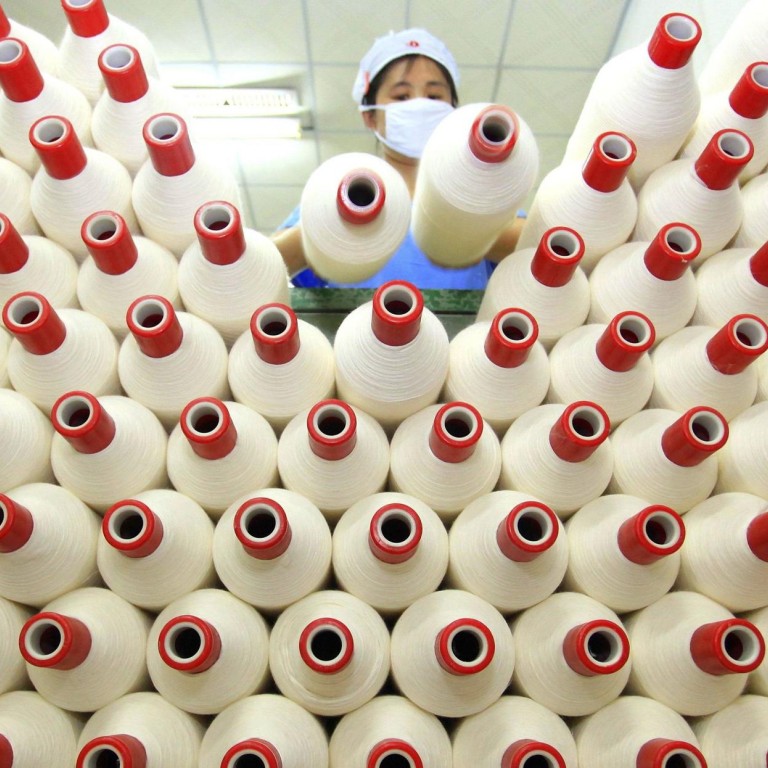
SMEs key to China's growth, yet they struggle with high wage, credit costs
Surging wages and higher borrowing costs put SMEs at a disadvantage, threatening the productivity gains needed to transform larger economy
Growing competition and cooling demand amid slower economic growth have added to pressure on mainland entrepreneurs to explore more profitable forms of expansion and reduce their reliance on cheap labour.
Small, private manufacturers say workers have stepped up wage demands, with labour costs rising by double-digit percentages in the past few years.
Meanwhile, tight credit supply through normal banking channels has made it harder to survive, let alone expand, managers told the
Failing to move up the value chain fast enough might see the mainland lose the battle to boost productivity and transform itself into a high-income economy, as countries such as Vietnam and Cambodia emerge as new, cheap global factory centres.
The rate spread between formal and shadow credit nationally was the highest … in a year
Tianjin Chuangda Construction chairman Xu Jilai said profit margins at his company had fallen to as low as 6 per cent, from about 10 per cent in 2008-2009 when the government injected 4 trillion yuan (HK$4.54 trillion) of credit to combat the effects of the global financial crisis.
Weaker demand and more expensive raw materials aside, Xu said surging labour costs had plagued Chuangda, with workers' wages rising by 20 per cent from last year and now one and a half times the level in 2009-2010.
He said some weaker, smaller companies were suffering much more than Tianjin Chuangda, which had annual revenue of hundreds of millions of yuan.
Wang Guangjun, chairman of car tyre dealer Xinjiang Qin Guang Xin Commercial and Trade, has also seen wage pressures increase.
"The workers demand higher salaries and the same social security coverage as those at state-owned enterprises," he said. "But how can private companies like us provide the same conditions as the SOEs?"
Wang said his company's borrowing costs were about 70 per cent higher than the prime lending rates banks offered to their best state-owned clients.
The mainland's gross domestic product grew by 7.4 per cent year on year in the first quarter of the year, the slowest rate in 18 months and a stark contrast to the double-digit growth seen for much of the past decade.
Mainland banks traditionally favour bigger clients, mostly SOEs that can offer sound collateral. Meanwhile, credit remains tight as regulators attempt to curb risks from asset bubbles following the lending binge of recent years. That has forced smaller companies into high interest loans, often from the shadow banking system, in order to sustain their businesses.
Leland Miller, president of data analytics firm China Beige Book International, said: "The rate spread between formal and shadow credit nationally was the highest we've seen in a year.
"With wages no longer cheap enough to draw firms to China for low-margin manufacturing, China must become more competitive if it wishes to compete globally.
"This means encouraging and promoting innovation, because Chinese firms won't stand a chance standing still."
Premier Li Keqiang has vowed to steer clear of massive stimulus that would only create false prosperity instead of sustained growth and has chosen instead to fine-tune economic policies by granting tax cuts for micro-sized firms and quickening export rebates.
But Qin Guang Xin's Wang said the situation for smaller companies had yet to improve significantly.
"We need more care from the state, such as giving us more support in bank funds or more opportunities in securing projects," he said.
Economists, such as Peking University professor Justin Li, formerly chief economist and a senior vice-president at the World Bank, have been calling on the mainland to further boost productivity to avoid the middle-income trap.
Many nations, such as Mexico and Brazil, have failed to find a way to quickly boost innovation and upgrade industrial structure. Struggling to create enough jobs in cities made it hard to cope with rapid inflows of migrant workers, causing the income gap to widen.
Economists say that developing small and medium-sized enterprises (SMEs) and upgrading their industrial capabilities are keys to economic transformation.
The Fung Global Institute, a Hong Kong-based independent think tank, said in a report that SMEs contributed more than 60 per cent of global GDP and more than 90 per cent of jobs.
"They are also a leading source of innovation," it said. "SME development is therefore key to promoting growth, innovation and jobs."
Some mainland companies have claimed initial success in withstanding the blows from the slowdown in economic growth thanks to early moves to upgrade their products.
China Jiaoguang, an exporter of light-emitting-diode (LED) lights and other electrical appliances based in Taizhou, Zhejiang, managed to turn around from deep losses by transforming its product range.
"It cost us more than 10 million yuan and five years to obtain the certificate necessary for us to enter the US energy-saving lights market," Chen Gongyue, a sales representative, told the
The company, once the mainland's 240th largest private enterprise, suffered from slumping external demand for its lights from 2007, forcing it to develop alternative products.
Chen said its LED lights met environmental requirements in the US and had a bright future.
"The situation in the past few years had been really, really dire," he said. "But the business began to recover since the end of 2012, with orders on the rise year on year since then."
Chen said the company's profit may reach 200 million yuan this year.

